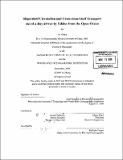| dc.contributor.advisor | Joseph Pedlosky and Glenn Flierl. | en_US |
| dc.contributor.author | Zhang, Yu | en_US |
| dc.contributor.other | Woods Hole Oceanographic Institution. | en_US |
| dc.date.accessioned | 2010-05-25T20:56:30Z | |
| dc.date.available | 2010-05-25T20:56:30Z | |
| dc.date.copyright | 2009 | en_US |
| dc.date.issued | 2009 | en_US |
| dc.identifier.uri | http://hdl.handle.net/1721.1/55165 | |
| dc.description | Thesis (Ph. D.)--Joint Program in Physical Oceanography (Massachusetts Institute of Technology, Dept. of Earth, Atmospheric, and Planetary Sciences; and the Woods Hole Oceanographic Institution), 2009. | en_US |
| dc.description | Cataloged from PDF version of thesis. | en_US |
| dc.description | Includes bibliographical references (p. 219-222). | en_US |
| dc.description.abstract | Interaction between the Antarctic Circumpolar Current and the continental slope/shelf in the Marguerite Bay and west Antarctic Peninsula is examined as interaction between a wind-driven channel flow and a zonally uniform slope with a bay-shaped shelf to the south. Two control mechanisms, eddy advection and propagation of topographic waves, are identified in barotropic vortex-escarpment interactions. The two mechanisms advect the potential vorticity (PV) perturbations in opposite directions in anticyclone-induced interactions but in the same direction in cyclone-induced interactions, resulting in dramatic differences in the two kinds of interactions. The topographic waves become more nonlinear near the western(eastern if in the Northern Hemisphere) boundary of the bay, where strong cross-escarpment motion occurs. In the interaction between a surface anticyclone and a slope penetrating into the upper layer in a two-layer isopycnal model, the eddy advection decays on length scales on the order of the internal deformation radius, so shoreward over a slope that is wider than the deformation radius, the wave mechanism becomes noticeably significant. It acts to spread the cross-isobath transport in a much wider range while the transport directly driven by the anticyclone is concentrated in space. A two-layer wind-driven channel flow is constructed to the north of the slope in the Southern Hemisphere, spontaneously generating eddies through baroclinic instability. A PV front forms in the first layer shoreward of the base of the topography due to the lower-layer eddy-slope interactions. | en_US |
| dc.description.abstract | (cont.) Perturbed by the jet in the center of the channel, the front interacts with the slope/shelf persistently yet episodically, driving a clockwise mean circulation within the bay as well as crossisobath transport. Both the transports across the slope edge and out of the bay are comparable with the maximum Ekman transport in the channel, indicative of the significance of the examined mechanism. The wave-boundary interaction identified in the barotropic model is found essential for the out-of-bay transport and responsible for the heterogeneity of the transport within the bay. Much more water is transported out of the bay from the west than from the east, and the southeastern area is the most isolated region. These results suggest that strong out-of-bay transport may be found near the western boundary of the Marguerite Bay while the southeastern region is a retention area where high population of Antarctic krill may be found. | en_US |
| dc.description.statementofresponsibility | by Yu Zhang. | en_US |
| dc.format.extent | 222 p. | en_US |
| dc.language.iso | eng | en_US |
| dc.publisher | Massachusetts Institute of Technology | en_US |
| dc.rights | M.I.T. theses are protected by
copyright. They may be viewed from this source for any purpose, but
reproduction or distribution in any format is prohibited without written
permission. See provided URL for inquiries about permission. | en_US |
| dc.rights.uri | http://dspace.mit.edu/handle/1721.1/7582 | en_US |
| dc.subject | Earth, Atmospheric, and Planetary Sciences. | en_US |
| dc.subject | Joint Program in Physical Oceanography. | en_US |
| dc.subject | Woods Hole Oceanographic Institution. | en_US |
| dc.subject.lcsh | Ocean currents | en_US |
| dc.subject.lcsh | Ocean circulation | en_US |
| dc.title | Slope/shelf circulation and cross-slope/shelf transport out of a bay driven by eddies from the open ocean | en_US |
| dc.type | Thesis | en_US |
| dc.description.degree | Ph.D. | en_US |
| dc.contributor.department | Joint Program in Physical Oceanography | en_US |
| dc.contributor.department | Woods Hole Oceanographic Institution | en_US |
| dc.contributor.department | Massachusetts Institute of Technology. Department of Earth, Atmospheric, and Planetary Sciences | |
| dc.identifier.oclc | 608055042 | en_US |
